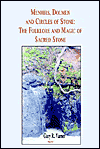
This is the kind of book readers want to love. Who doesn’t adore standing stones? Who isn’t interested in the lore, the mystery, and, yes, the magical aura of stone circles and barrows and other megalithic constructions?
This is not, alas, the book we’ll love. For starters, although the author, a member of the American Folklore Society, begins by defining terms—a menhir is a “single standing stone or a monolith” and dolmen refers to “a large room-shaped structure consisting normally of three upright stones with a stone roof-slab” (p. 2)—he doesn’t seem to know if he wants to use “dolmen” or “dolmens” as the plural noun and he does not use the word cromlech, which the OED says is the proper word for “dolmen.” In a book whose title suggests he’s writing about large standing stones (megaliths), the author also has a chapter in which he discusses crystals, pieces of jade and flint and obsidian, and “druid’s eggs” (though he never tells us precisely what these are), and “gifts from faeries” (and he spells it both “fairy” and “faery”).
As you read, you begin to wonder about the organization of the book. It’s like a trip around the world attached to a bungee cord. Stone circles and rocking stones and stones with inscriptions and energetic stones are all visited, sometimes in several countries in the same paragraph. It’s as if the author shuffled his 5x7” index cards, set the stack next to his keyboard, and began typing. And typed just what was written on each card, without transitions. He’s very careful, however, with his footnotes, which run consecutively throughout the book (all the way up to 448), which makes for some funny spacing at the ends of sentences. (The more common approach is to start again at 1 with a new chapter and most books these days use endnotes.) But occasionally he needs another citation, as when he writes that “more recent” folklore “says that the Avebury stones are gravestones for King Arthur’s men who fell in the Battle of Mount Badon” (p. 95). Who said that? And sometimes he just doesn’t quite make sense, as when he says the Kensington Rune Stone in Minnesota was possibly a hoax “perpetrated by a neighbor” (p. 103), but neglects to say a neighbor of whom.
Nevertheless, there is good stuff in the book, as when the author says that the omphalos “has become transmorphed into our foundation stones in large buildings” and says that local politicians and businessmen with their “shiny shovels” and time capsules may be creating a shamanic opening into the past for future excavators (p. 44). He also gives numerous references to the tribes of coastal California (about whom not enough is known) and their sacred sites and stones, briefly describes sacred stones in Belarus, tells us about a stone in a commercial building in London that is that city’s omphalos, and wonders if the ancient Hebrew might have worshipped a god of stone at Beth’el.
This book is not friendly to pagans, witches, or those who worship the Goddess. The author quotes old sources (often citing only 1990s reprints without giving the original date of publication) that frown on “pagan rites” and evil witches. It’s also curious that in one of his discussions of the Rollrights, he informs us that in 1955 “a split-end hazel wand was found … left behind from a ritual held the night before. The wand is now in the Museum of Witchcraft at Boscastle, Cornwall” (p. 114).
It’s likely that the faults in this book lie not with the author but with the publisher. One wonders about the competencies of a publisher that calls itself academic but releases what looks like a really good rough draft of a book. Why didn’t they organize it more logically? Make some decisions about consistency of spelling? Don’t they know how to format footnotes? Why didn’t they recognize the typos? This author worked hard; he deserves a better publisher.
~review by Barbara Ardinger, Ph.D.
Author: Gary R. Varner
Algora Publishing, 2004
pp. 236, $21.95
